General
In 1883 the Nursing Sisterhood of St John the Divine (an Anglican Sisterhood developed in association with King's College Hospital) opened the St John's Hospital in some small houses in Cressingham Road, Lewisham. The Hospital had 10 beds.
This Hospital soon moved to a building in Montague Place in Poplar (but closed in 1889). However, a new hospital was opened by the Sisterhood in the former All Saints' Boys Orphanage in Morden Hill, Blackheath. Originally named the St Stephen's Hospital for Women and Children, it was renamed in 1886 as the St John's Hospital for Men and Women, 'for the treatment of the sick poor'.
In 1897 an anonymous donation enabled the building of a new ward block, which opened in 1900 with 38 beds. The old Hospital building became the Nurses' Home.
From 1901 to 1920 the Hospital continued to expand its bed accommodation, especially with the financial help of a voluntary staff doctor, Dr Ernest Ofenheim. Ward blocks and a main kitchen were added on the west side of the slite, along Morden Hill. In 1911 an X-ray department and a laboratory were installed. By 1913 the Hospital had 46 beds.
During WW1 wounded British and Belgian soldiers were admitted for treatment.
In 1919 a new building to house the dental, electrical and massage departments was built at the northwest of the site.
An Out-Patients Department was erected on the Lewisham Road side in 1921. By 1923, with the addition of another new ward block, the Hospital had expanded to 102 beds, whilst the Out-Patients Department dealt with 100,000 attendances a year. The following year a new waiting room and Almoner's office were added.
In 1924, due to a lack of recruitment to the Sisterhood, a Training School for Nurses was formed, approved by the General Nursing Council. The Community of St John the Divine resigned all their rights and duties in the Hospital (but their traditional uniform and badge continued to be worn until 1948, when the Hospital joined the NHS). Management of the Hospital passed to a Court of Governors, elected by the subscribers. This meant that the Hospital was responsible for raising its own funds to carry on its work.
The reputation of the Hospital grew because of its splendid nursing and the family atmosphere of its wards and clinics. Patients came from Lewisham, Greenwich, Deptford, Woolwich and parts of Kent - Bexleyheath, Dartford and Orpington.
In 1925 a new Nurses' Home was built on the corner of Lewisham Hill and Blackheath Rise, and various houses in Blackheath Rise were acquired by the Hospital over the next few years for use as offices (Nos. 5-7), night nurse quarters (No. 13) and the Secretary's house (No. 17).
During WW2 the Hospital reserved 50 beds for the Ministry of Health, retaining 52 for civilian casualties from air-raids, etc. The Hospital itself was damaged nine times by bombs. West Bank, attached to the Nurses' Home, was completely destroyed and Cedar Lodge, housing the dental and massage departments, was rendered unusable. The Out-Patients Department was also hit but was repaired and re-opened after only two weeks.
After the war the work of repairing war-damaged buildings continued - the Ofenheim Wing, Brandon House and the King Edward Memorial buildings were restored in 1947. An extension was added to the 1938 Nurses' Home and a new building erected for Central Stores. At this time the Hospital had two male wards, three female wards and one for children, as well as seven rooms for private patients. However, there was a serious shortage of student nurses.
In 1948 the Hospital joined the NHS under the control of the Lewisham Group Hospital Management Committee, part of the South East Metropolitan Regional Hospital Board.
By 1954 it had 112 beds, but its future as a general hospital came under threat. The Minister of Health proposed to close the urology department and to send the patients elsewhere to be treated. The ENT department was also threatened, as it was felt patients could be moved to the under-utilized Park Hospital, two miles away at Hither Green. This was perceived by the medical staff as having a detrimental effect on nursing recruitment; students at the Nursing School would have to be seconded to other hospitals to complete their training.
In December 1957 a train crash occurred just outside St John's railway station. The casualties were taken to Lewisham Hospital, St John's Hospital and Grove Park Hospital. Ninety two people were killed and 173 injured.
In 1974, following a reorganisation of the NHS, the Hospital came under the administration of the Lewisham District Health Authority, part of the South East Thames Area Health Authority.
In 1982, despite vigorous local protest, the Area Health Authority decided to close the Hospital.
The Hospital buildings were vacated and boarded up, but became derelict. In 1985 the houses at 13 and 15-17, Blackheath Rise, were squatted.
The site was sold in 1986 for £7.3m to Hyde Housing Association. Although it had been recommended that the vandalised 1938 Nurses' Home be restored, that building was demolished along with the rest of the Hospital.
The site was redeveloped into a housing complex - the St John's estate. The foundation stone remains, inset into a wall in Smiles Place, on the southern part of the site.

The foundation stone and name of the Hospital inset into a wall in Smiles Place.
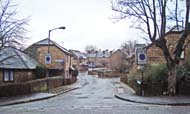
The entrance to Oppenheim Road at the east of the site.
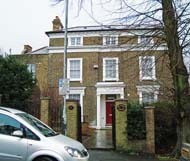
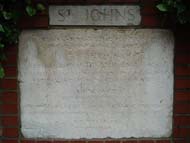
The foundation stone is now almost illegible.
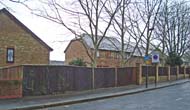

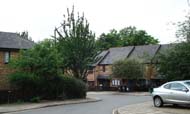
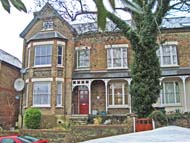
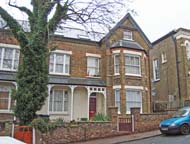
Nos. 13 and 15 Blackheath Rise, former Hospital buildings
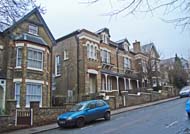
No. 17 Blackheath Rise, used by the Hospital as the Secretary's house.

The boarded-up former Nurses' Home (above and below), photographed in about 1989. (Photographs courtesy of Michael Bullock, Australia)
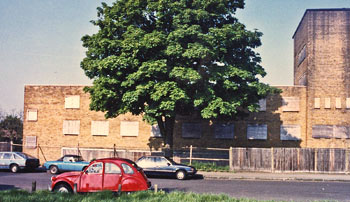
Largely due to his efforts and generosity, the Hospital developed from a small institution to one of the best equipped voluntary hospitals, with 100 beds and a Nurses' Home. He established various departments in new or converted buildings and also purchased the land surrounding the Hospital, making it over as a freehold gift.
Hating publicity and applause, his charitable undertakings were largely unsung, but he donated a large portion of his income to those in need. His secret gifts to St John's Hospital were worth more that £50,000.
He is perhaps best remembered as a children's doctor, making sure that the children under his care received a new penny every Sunday.
It had been intended that one of the new roads on the redeveloped St John's Estate would be named after him, but the local authorities decided that 'Oppenheim' was the more 'correct' English spelling of 'Ofenheim', thus Oppenheim Road was born.
(Author unstated) 1998 A Rich Past...An Exciting Future. London, The Lewisham Hospital NHS Trust.
Cartwright FF 1954 St John's Hospital, Lewisham. British Medical Journal 2 (4893), 931.
Erskine D 1954 Correspondence. St John's hospital, Lewisham. British Medical Journal 2 (4898), 1231-1232.
Winsbury White HP 1954 Urology at St John's Hospital, Lewisham. British Medical Journal 2 (4891), 811.
www.aim25.org.uk
www.kcl.ac.uk
Return to home page